Escaping the Curriculum by Returning to Student Voice
This blog post was written by Ash Beck, a Middle School Design Technology teacher at Washington International School
It was a typical day in 8th Grade Design Technology class, at the start of a new unit about sustainable design. My carefully planned lesson was disrupted when a student suggested an escape room unit. When others responded enthusiastically, I immediately recognized a rich opportunity for inquiry-led, student-centered learning. There was only one problem: I had no idea how to design an escape room (a room with a series of puzzles centered around a theme where participants race against the clock to escape). Luckily, Design Technology is all about identifying and solving problems–and is an elective class where I can easily modify the curriculum.
The student goals for this unit were to design an escape room using the design cycle as our framework (Investigate, Plan, Create and Evaluate). They would set up the room, and we would have the 7th grade Design Technology class complete the escape room on their last day of the semester. The goals for me as a teacher were to provide as authentic a learning experience as possible and to support students in their thinking. I wanted to be as hands- off as possible and let them experience struggle, failure, and problem-solving without swooping in to save them. I saw myself as a facilitator and took on all the adult-specific tasks. Otherwise, they were in charge.
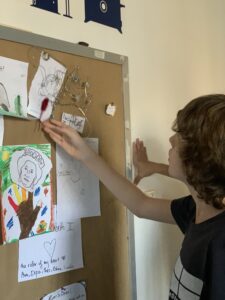
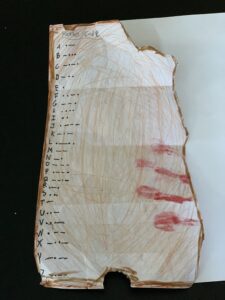
Immediately, students got to work on different aspects of the escape room. Some were invested in the narrative behind it, while others were primarily concerned with the clues. In the narrative, the participants of the escape room are put in prison for cutting the queue at Queen Elizabeth II’s funeral. The students created clues related to her life that the participants would use to escape once they pieced together a four digit code that they entered into an iPad on the door handle. I assigned them a slideshow to document their thinking and designs, which included the story, clues, and overall operations of the room. I told them the slides should serve as an instruction manual and be detailed and clear, so that someone could facilitate the room without having any prior knowledge or experience. This helped them communicate their ideas clearly and synthesize the various parts of the design.
The first struggle we encountered was that everyone was working on separate parts of the escape room without communicating with each other. The student who wanted to take charge had a difficult time compromising and delegating. This led to the first of many conflicts between students as they tried to create a coherent sequence and narrative while advocating for their own ideas. I stepped in to help facilitate communication. Apart from this obstacle, the students were very invested in designing the room, creating clues, and organizing the flow through the slides.
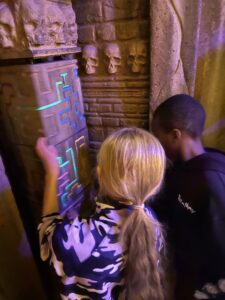
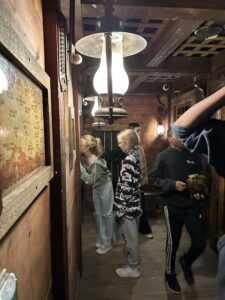
The day of our research field trip, we encountered another obstacle–the school bus wouldn’t start. The students solved this problem by finding an alternate route to the escape room via Metrobus. Once we were in the escape room, we had a lot of fun solving the clues and thinking about how we could learn from this escape room design and implement features into our own. We almost escaped, but in the end we were not successful. We were impressed to learn that we had chosen the hardest one! A kind worker showed us a few of the other escape rooms and told us about the process of designing them. Back in the classroom, we debriefed about our experience and what we wanted to change about our designs.
Next, we had some adult volunteers come test out our escape room prototype. The students were feeling the pressure as they scrambled to tie up loose ends in their clues and the flow of the experience. Our prototype testers provided invaluable feedback, as we prepared the room for the 7th grade Design Technology students. Seeing people test out their prototype in real life helped them identify gaps and weak points. Before this experience, I had several confident students who thought our planning was perfectly clear and needed no adjustments. They had a rude awakening when they saw their plans fall apart and the testers behave unpredictably. Things did not go according to plan, but instead of being discouraged, we were able to see how our failure pointed out areas for growth.
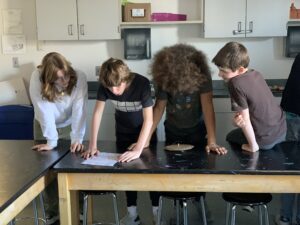
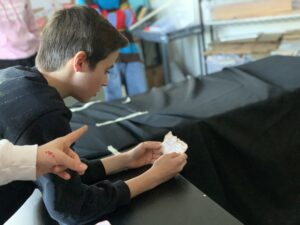
Finally, the big day arrived. We had a few of the 8th grade students come to the 7th grade class to facilitate the escape room. The 7th graders had a lot of fun and successfully escaped. The latest prototype was much more streamlined and clear.
If I were to do this unit again, I would have a clearer schedule to present to students. Since this was our first time, I had no concept of how long things would take. I would also explicitly discuss strategies for working in groups and interpersonal issues. Otherwise, my main objective, for students to lead this unit using the design cycle with minimal teacher intervention, was wildly successful.


